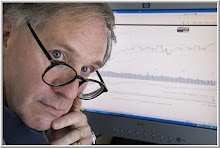
5/28/2025 - What I see happening in the best training of trader talent at hedge funds is a marriage of top-down and bottom-up analyses. Top down analyses are often historical studies of how a stock or market has behaved under a given set of circumstances. For instance, if a company reports earnings that are significantly above consensus, how does its stock tend to behave over subsequent time periods? Or, if interest rates make a new month-long high, how do different stock market sectors tend to behave going forward? The top-down analyses provide a big picture of where there might be edge going forward.
The bottom-up analyses are all about shorter-term pattern recognition and how a stock or market tends to behave when price and volume meet certain criteria. For example, if a stock trades with high relative volume and breaks above a two-day range, how does it tend to behave during the remainder of the trading session?
The marriage of top-down and bottom-up analyses aids trading psychology because traders understand what the edge is, why it is there, and what to do about it. That broader understanding contributes to confidence in the idea and the ability to take meaningful risk when the odds are in the trader's favor. Great traders, like great poker player, know the hands they are playing, the odds of winning with those hands, and how to best bet those hands.
5/26/2025 - So how do teams in professional trading settings help their members trade at their best? They do so by exchanging ideas on: 1) Why to trade (what are catalysts for buying/selling); 2) What to trade (what instruments/stocks will best exploit the reasons for taking risk); and 3) How to trade (what would provide ideal risk/reward entries; what would be opportunities to size up positions; how positions would best be structured for risk/reward). In other words, teams don't just share ideas for entering trades. They collaborate to get the most from those trades. What to trade is just as important as why to trade. How to trade is just as important as what to trade. When teams review their trading together, they internalize lessons in making the most from their ideas.
5/25/2025 - Below we can appreciate how teamwork helps us make the most of our talents and accelerates the development of our skills. Teamwork also builds our trading psychology, as we are motivated to help others and serve as a role model for them. Basic training produces soldiers ready for combat in grueling circumstances. The right training in markets similarly produces a robust mindset in the face of uncertainty and setback.
So how can individual, independent traders gain the benefits of teamwork? A first step in the right direction is to find a trading partner who is committed to working with you and who you are committed to helping. A two-person team more than doubles the benefits of sound trading processes. By performing separate research and then brainstorming findings, a trading pair can generate ideas that neither had come up with on their own. Similarly, when reviewing performance together, the lessons learned from our partners, combined with our own lessons, can stimulate creative ideas for making trading improvements.
Too, working as a pair improves trading psychology as each member focuses on helping the other. That keeps everyone constructive. The interactions tap into social motivations, keeping both members helpfully engaged. Training programs for traders and trading communities can be great places to start the search for trading partners. Following traders who post on social media may also lead to useful collaborations.
Teamwork creates synergies...even when the team is two.
========
I work with a number of portfolio managers at hedge funds. Here are a few facts about them:
* All of them have a history of success in financial markets; that is why they are managing hundreds of millions of dollars or more.
* None of them discuss with me emotional, impulsive trading, FOMO, revenge trading, etc. The issues that trouble beginning traders are largely irrelevant to experienced, profitable market participants. Through their training, they have learned to operate by clearly defined processes.
* All of them work in teams. The best teams consist of members who have their own unique strengths. When everyone on a team is better than everyone else in some area, then everyone can make everyone better and the whole is much greater than the sum of the parts.
* The best teams work as hard on their teamwork as on their markets. They constantly look to improve what each person looks at, how they look at it, and how they communicate. They work as hard on team goals as individual goals. They review team performance every bit as much as they review their own individual performance.
* The best teams work hard on maintaining a positive, supportive culture. They take time outside market hours to play and celebrate, as well as to meet and plan. The best team members support one another and motivate each other. When I have observed teams at hedge funds and prop firms like SMB, for example, I've invariably noticed that they enjoy their interactions.
Being part of a trading community is helpful, but it does not substitute for being part of a committed team that coordinates trading efforts day in and day out. Show me a performance field where people earn their livings from stellar performance and I'll show you a field where performance is a function of teamwork. Even the Olympic athletes succeeding in individual events train as a team and benefit from the teamwork of mentoring and coaching.
Read this carefully: A lack of discipline in trading comes from a lack of teamwork in training. No one becomes a disciplined, elite soldier on their own. It takes teamwork to make our dreams work.
.













